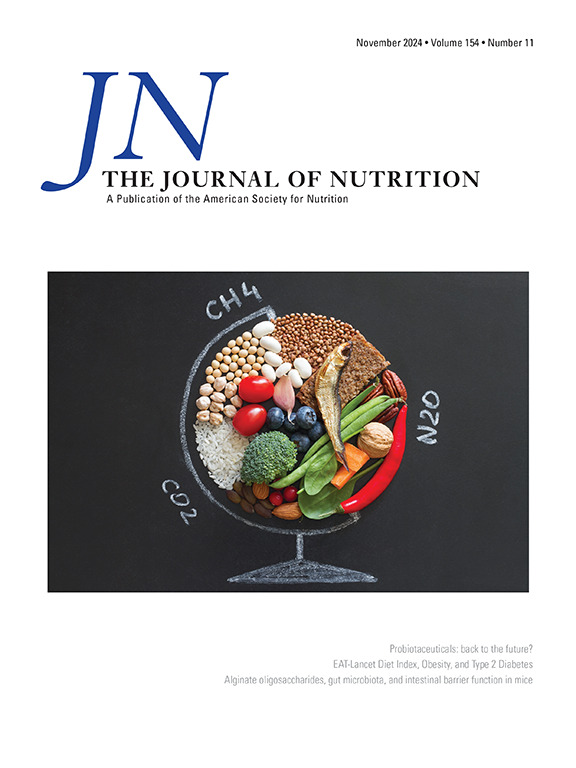Impact of an Integrated Intervention Package During Preconception, Pregnancy, and Early Childhood on the Gut Microbiome at Six Months of Age: Findings from the Women and Infants Integrated Growth Study (WINGS) Randomized Controlled Trial
IF 3.7
3区 医学
Q2 NUTRITION & DIETETICS
引用次数: 0
Abstract
Background
The infant gut microbiome is essential for healthy growth and development. However, limited research has explored how interventions targeting maternal and infant health, nutrition, and psychosocial conditions during preconception, pregnancy, and early childhood impact microbiome development. To address this research gap and better understand the potential impact of such interventions, this study was designed to evaluate their effects on the infant gut microbiome.
Objective
The aim was to evaluate the effects of an integrated intervention package on infant gut microbiome at 6 mo of age compared with routine care.
Methods
The study was embedded in a randomized factorial trial involving women aged 18–30 y. Participants were randomly assigned to receive either a preconception intervention package or routine care until pregnancy. Pregnant women were then randomly assigned to receive a pregnancy and early childhood intervention package or routine care. The intervention included health care for growth-related conditions, nutrition, water, sanitation, and hygiene (WASH), and psychosocial care. Stool samples from 392 infants (185 from the preconception, pregnancy, and early childhood intervention group and 207 from the routine care group) were collected at 6 mo, followed by microbiome DNA isolation and high-throughput sequencing of the V3-V4 region of 16S rRNA gene. Generalized linear models were used to estimate the mean relative abundance of core gut microbiome phyla, genera, and species between the intervention and routine care groups.
Results
Infants in the group who received preconception, pregnancy, and early childhood intervention had a significantly lower mean relative abundance of Klebsiella genus under the Pseudomonadota phylum (45% lower; 95% confidence interval [CI]: 18, 63) and Klebsiella pneumoniae species (38% lower; 95% CI: 8, 59) compared with routine care group. In contrast, the relative abundance of Megasphaera (72% higher; 95% CI: 7, 175), Prevotella (72% higher; 95% CI: 3, 187), and Bifidobacterium breve (34% higher; 95% CI: 2, 79) was significantly higher in the group received preconception, pregnancy and early childhood intervention compared with routine care.
Conclusions
The findings indicate that improving maternal and infant health, nutrition, and psychosocial conditions enhances the relative abundance of beneficial gut bacteria at 6 mo of age, supporting healthy growth and development.
This trial was registered at Clinical Trials Registry–India as CTRI/2020/10/028770; https://ctri.nic.in/Clinicaltrials/advsearch2.php
孕前、妊娠和幼儿期综合干预方案对6个月时肠道微生物组的影响:来自妇女和婴儿综合生长研究(WINGS)随机对照试验的发现
婴儿肠道微生物群对健康生长发育至关重要。然而,有限的研究探索了孕前、妊娠和幼儿期针对母婴健康、营养和社会心理状况的干预措施如何影响微生物群发育。为了解决这一研究空白并更好地了解此类干预措施的潜在影响,本研究旨在评估其对婴儿肠道微生物组的影响。目的评价综合干预方案对6月龄婴儿肠道微生物组的影响,并与常规护理进行比较。方法本研究是一项随机因子试验,涉及18-30岁的女性。参与者被随机分配接受孕前干预包或常规护理,直到怀孕。然后,孕妇被随机分配接受妊娠和幼儿干预包或常规护理。干预措施包括针对生长相关疾病的保健、营养、水、环境卫生和个人卫生(WASH)以及心理社会护理。在6个月时收集392名婴儿的粪便样本(孕前、妊娠和幼儿干预组185名,常规护理组207名),随后进行微生物组DNA分离和16S rRNA基因V3-V4区高通量测序。使用广义线性模型来估计干预组和常规护理组之间核心肠道微生物组门、属和种的平均相对丰度。结果接受孕前、妊娠和幼儿干预组的婴儿假单胞菌门克雷伯氏菌属的平均相对丰度显著降低(降低45%;95%可信区间[CI]: 18,63)和肺炎克雷伯菌(降低38%;95% CI: 8,59)与常规护理组比较。相比之下,Megasphaera的相对丰度(高出72%;95% CI: 7,175),普雷沃氏菌(高出72%;95% CI: 3187)和短双歧杆菌(34%高;95% CI: 2.79)与常规护理相比,接受孕前、妊娠和幼儿干预的组明显更高。研究结果表明,改善母婴健康、营养和社会心理状况可提高6月龄时有益肠道细菌的相对丰度,支持健康生长发育。该试验已在印度临床试验注册中心注册为CTRI/2020/10/028770;https://ctri.nic.in/Clinicaltrials/advsearch2.php
本文章由计算机程序翻译,如有差异,请以英文原文为准。
求助全文
约1分钟内获得全文
求助全文
来源期刊

Journal of Nutrition
医学-营养学
CiteScore
7.60
自引率
4.80%
发文量
260
审稿时长
39 days
期刊介绍:
The Journal of Nutrition (JN/J Nutr) publishes peer-reviewed original research papers covering all aspects of experimental nutrition in humans and other animal species; special articles such as reviews and biographies of prominent nutrition scientists; and issues, opinions, and commentaries on controversial issues in nutrition. Supplements are frequently published to provide extended discussion of topics of special interest.
 求助内容:
求助内容: 应助结果提醒方式:
应助结果提醒方式:


